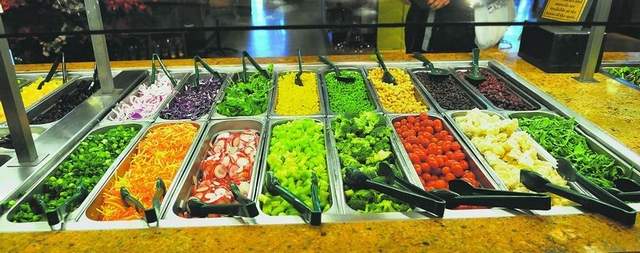Simple Steps to a Healthier Salad Bar Meal
My kids recently informed me that their school added a salad bar to the cafeteria. I was really pleased with this news since it provides the kids who purchase their lunch with another healthy meal option. The problem is that some of Alex’s friends who are visiting the salad bar are coming back with a mound of lettuce and cheese smothered in salad dresssing. Not exactly a healthy salad in my book.

Salad bars aren’t as popular in restaurants as they once were, but they still exist in quite a few. I decided to pull together a list of salad “fixin’s” to avoid and those you can add generously to your plate guilt-free. You’ll start with greens as your base. Most salad bars will provide an option of just iceberg lettuce or a mix of greens such as romain lettuce with darker greens like spinach or red leaf lettuce. Opt for the darker greens as they contain more nutrients. Now you’re ready to add other veggies and toppings to your salad. Make it interesting and colorful! A healthy tip is to cover all the colors of the rainbow if possible since different colors provide different kinds of vitamins and minerals. Here are some common salad bar items you’ll want to load your plate with:
- sliced bell peppers
- sliced onion
- grape tomatoes
- beans (usually pinto or garbanzo beans are used at salad bars)
- carrots
- chopped celery
- peas (these are frozen peas defrosted and are a terrific topping)
- broccoli or cauliflower flowerets
- cucumber slices
- fresh mushrooms
- fresh fruit salad or sliced fruit for a side treat
Now that you have all the ingredients for your salad you’ll be tempted to add some of the higher fat or calorie toppings like croutons or cheese. Instead, substitute a sprinkle of parmesan cheese in place of cheddar cheese to get the flavor without the calories and fat. Add a few seeds for the crunch of the croutons and you’ll also be adding heart healthy fats to your meal. When selecting your dressing avoid the creamy, high-fat options. The best choice is a bit of olive oil and either red wine or balsamic vinegar. If you’re really wanting a specific kind of dressing, fill a seperate cup and dip your fork in the dressing rather than pouring it over your salad. This will help you control how much you’re consuming–remember, regular dressings are extremely high in fat, calories and sodium.
A few items at the salad bar to really avoid are all those mayo-based, pre-made salads like potato salad, macaroni salad, etc. Honestly, they’re all high in calories, fat and they’re not filled with the reason you’re at the salad bar to begin with–veggies!!! And, I’ll bet you didn’t go to a restaurant to fill up on potato or macaroni salad, did you?
One final thought–the next time you visit a salad bar, if you have a child, bring him or her with you. This way you can show your child the right selections to make and you have a better chance of ending up with a teen who won’t visit the salad bar at school and come back with a pile of lettuce, cheese and dressing!
See all posts


